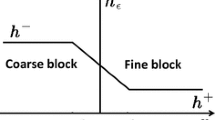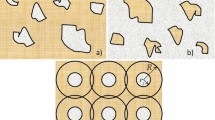Abstract
Recently developed transport equations for two-phase flow through porous media usually have a second term that has been included to account properly for interfacial coupling between the two flowing phases. The source and magnitude of such coupling is not well understood. In this study, a partition concept has been introduced into Kalaydjian's transport equations to construct modified transport equations that enable a better understanding of the role of interfacial coupling in two-phase flow through natural porous media. Using these equations, it is demonstrated that, in natural porous media, the physical origin of interfacial coupling is the capillarity of the porous medium, and not interfacial momentum transfer, as is usually assumed. The new equations are also used to show that, under conditions of steady-state flow, the magnitude of mobilities measured in a countercurrent flow experiment is the same as that measured in a cocurrent flow experiment, contrary to what has been reported previously. Moreover, the new equations are used to explicate the mechanism by which a saturation front steepens in an unstabilized displacement, and to show that the rate at which a wetting fluid is imbibed into a porous medium is controlled by the capillary coupling parameter, α. Finally, it is argued that the capillary coupling parameter, α, is dependent, at least in part, on porosity. Because a clear understanding of the role played by interfacial coupling is important to an improved understanding of two-phase flow through porous media, the new transport equations should prove to be effective tools for the study of such flow.
Similar content being viewed by others
References
Avraam, D. G. and Payatakes, A. C.: 1995, Generalized relative permeability coefficients during steady-state two phase flow in porous media, and correlation with flow mechanisms, Transport in Porous Media 30, 135-168.
Ayub, M. and Bentsen, R. G.: 1999, Interfacial viscous coupling: a myth or reality, J. of Petr. Sci. Engng 23, 13-26.
Babchin, A., Yuan, J. and Nasr, T.: 1998, Generalized phase mobilities in Gravity drainage processes, Paper 98-09 presented at the 49th Annual Technical Meeting of the Petroleum Society of CIM Calgary, Alberta, Canada, June 8-10.
Bacri, J., Chaouche, M. and Salin. D.: 1990, Modèle simple de perméabitiés croisées, C.R. Acad. Sci. Paris, 311(11), 591-596.
Bentsen, R. G.: 1992, Construction and experimental testing of a new pressure-difference equation, AOSTRA J. Res. 8, 159-168.
Bentsen, R. G.: 1994, Effect of hydrodynamic forces on the pressure-difference equation, Transport in Porous Media 17, 133-144.
Bentsen, R. G.: 1997, Impact of model error on the measurement of flow properties needed to describe flow through porous media, Revue de L'Institute Français du Pétrole 52(3), 299-315.
Bentsen, R. G.: 1998a, Influence of hydrodynamic forces and interfacial momentum transfer on the flow of two immiscible phases, J. of Petr. Sci. Engng 19, 177-190.
Bentsen, R. G.: 1998b, Effect of momentum transfer between fluid phases on effective mobility, J. of Petr. Sci. Engng 21, 27-42.
Bentsen, R. G. and Manai, A. A.: 1991, Measurement of cocurrent and countercurrent relative permeability curves using the steady-state method, AOSTRA J. Res. 7, 169-181.
Bentsen, R. G. and Manai, A. A.: 1993, On the use of conventional cocurrent and countercurrent effective permeabilities to estimate the four generalized permeability coefficients which arise in coupled, two-phase flow, Transport in Porous Media 11, 243-262.
Bourbiaux, B. J. and Kalaydjian, F. J.: 1990, Experimental study of cocurrent and countercurrent flow in natural porous media, SPERE 5, 361-368.
Buckley, S. E. and Leverett, M. C.: 1942, Mechanism of fluid displacement in sands, Trans. AIME 146, 107-116.
Chatenever, A. and Calhoun, J. C. Jr.: 1952, Visual estimation of fluid behavior in porous media — Part I, Trans. AIME 195, 149-156.
Collins, R. E.: 1990, Flow of Fluids through Porous Media Materials, Research and Engineering Consultants, Englewood, CO, 161 ff.
de la Cruz, V. and Spanos, T. J. T.: 1983, Mobilization of oil ganglia, AIChE J. 29 (5), 854-858.
Dullien, F. A. L. and Dong, M.: 1996, Experimental determination of the flow transport coefficients in porous media, Transport in Porous Media 25, 97-120.
Kalaydjian, F.: 1987, A macroscopic description of multiphase flow in porous media involving spacetime evolution of fluid/fluid interface, Transport in Porous Media 2, 537-552.
Katchalsky, A. and Curran, P. A.: 1975, Nonequilibrium Thermodynamics in Biophysics, Harvard Univ. Press, Cambridge, 83 ff.
Lelièvre, R. F.: 1966, Etude d'écoulements disphasiques permanents à contre-courants en milieu poreux — Comparison avec les écoulements de même sens (in French), PhD Thesis, University of Toulouse, France.
Muskat, M.: 1982, The Flow of Homogeneous Fluids through Porous Media, Int. Human Resour. Dev. Corp., Boston, 127 ff.
Rakotomalala, N., Salin, D. and Yortsos, Y. C.: 1995, Viscous coupling in a model porous medium geometry: effect of fluid contact area, App. Sci. Res. 55, 155-169.
Rapoport, L. A. and Leas, W. J.: 1951, Relative permeability to liquid in liquid-gas systems, Trans. AIME 192, 83-98.
Rose, W.: 1990, Coupling coefficients for two-phase flow in pore spaces of simple geometry, Transport in Porous Media 5, 97-102.
Rose, W.: 1993, Coupling coefficients for two-phase flow in pore spaces of simple geometry, Transport in Porous Media 10, 293-296.
Sarma, H. and Bentsen, R. G.: 1989, A new method for estimating relative permeabilities from unstabilized displacement data, J. Can. Petr. Tech. 28(4), 118-128.
Whitaker, S., 1986, Flow in porous media: II. The governing equations for immiscible, two-phase flow, Transport in Porous Media 1, 105-125.
Zarcone, C. and Lenormand, R.: 1994, Détermination expérimentale du couplage visqueux dans les écoulements diphasiques en milieu poreux, C.R. Acad. Sci., Paris, Series II, 318, 1429-1438.
Author information
Authors and Affiliations
Rights and permissions
About this article
Cite this article
Bentsen, R.G. The Physical Origin of Interfacial Coupling in Two-Phase Flow through Porous Media. Transport in Porous Media 44, 109–122 (2001). https://doi.org/10.1023/A:1010791526239
Issue Date:
DOI: https://doi.org/10.1023/A:1010791526239




